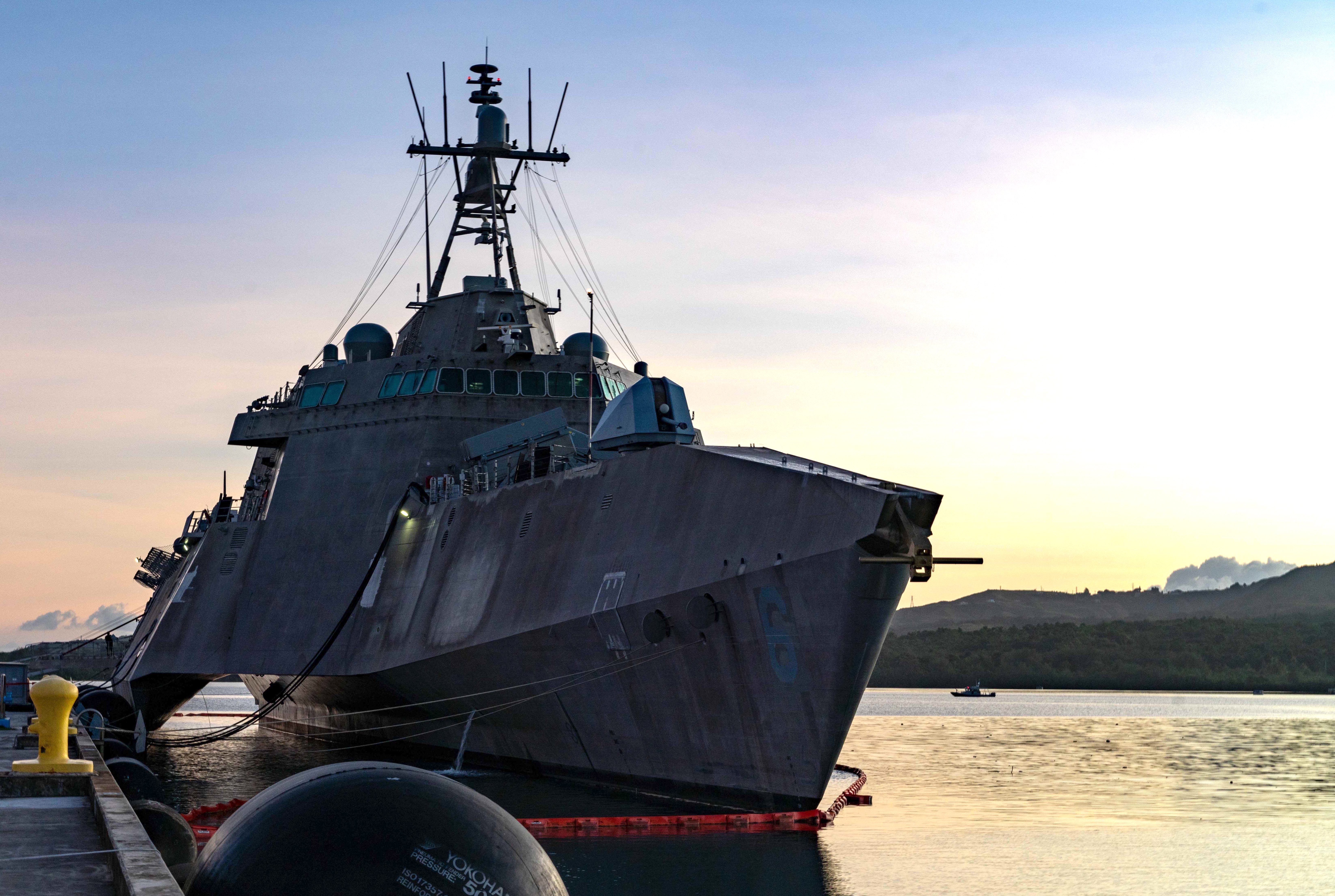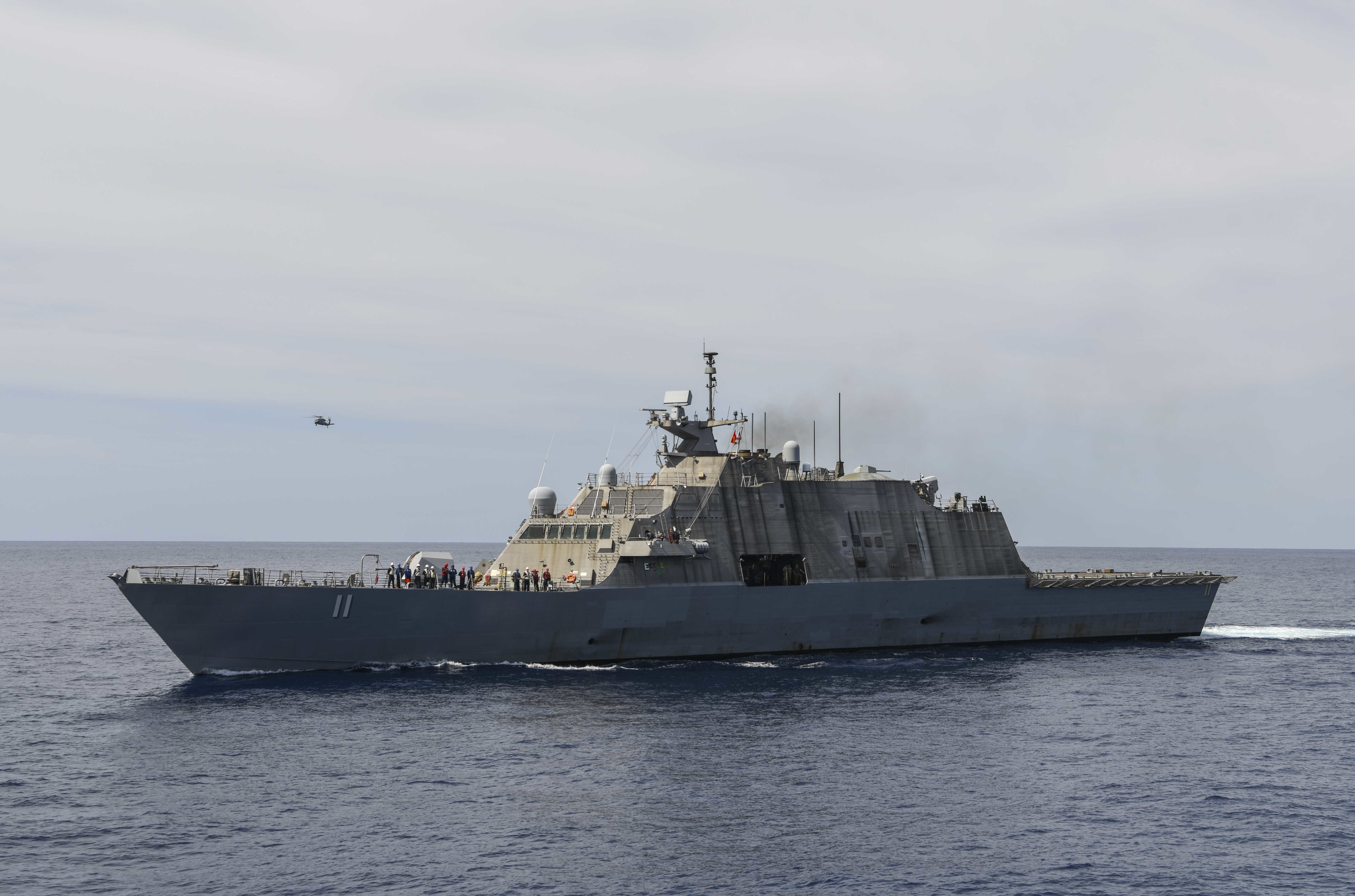
ARLINGTON, Va. — The Navy could deploy the aluminum hull, Independence-class Littoral Combat Ship to the Middle East as part of a future mine-countermeasures force in U.S. Central Command, service officials said.
Vice Adm. Roy Kitchener, the commander of Naval Surface Forces, said the Navy could send up to two of the Independence-class to Bahrain with a variant of the LCS MCM mission package in the same way the service’s Avenger MCM are deployed now.
“The plan is to use the Independence variant to go out there with that MCM capability, but we are also looking at other options,” Kitchener told reporters last week.
“One is to forward deploy ships out there. There was a thought that maybe there’ll be two ships that deploy off the West Coast, just to go out there. But we’re also looking at what would it take to actually leave those ships out there, kind of like we have the Avengers out there now.”
The West Coast-based Independence-class has been working for years to certify pieces of the MCM mission package that will operate from the platform, while at the same time developing an expeditionary MCM.
The initial mission package was set for use on both the Independence-class LCS and the steel, mono-hulled Freedom-class. But the Navy has been backing away from operating the Florida-based Freedoms, putting the bulk of the class up for early decommissioning.
“We have a very robust expeditionary MCM capability and we’re trying to leverage that as much as we can and seeing how that fits into the mix. So there’s several different things going on. But right now, I think the plan of record, as it stands, is yeah it would be an [Independence] variant MCM capability out there,” Kitchener said.
“We are working on several other options to see how we can fill that. And I personally think the answer is going to be something that is forward deployed to Bahrain.”
The goal is to get the Independence-class ships to CENTCOM by 2025 and to U.S. Indo-Pacific Command by 2027. The Navy had long planned to send the Freedom-class hulls to CENTCOM.
“There’s a concern with Independence class that as we move that – our goal is 2025 to put it into CENTCOM – the infrastructure in Bahrain may not quite be right for Independence class,” Brig. Gen. Marcus Annibale, the director of expeditionary warfare on the chief of naval operations’ staff (OPNAV N95), said Wednesday at the Surface Navy Association’s annual symposium. “The Freedom-class may be a good vessel of opportunity … to make those packages together with some of those capabilities.”
The Navy is close to reaching initial operating capability for the MCM mission package after trials on USS Cincinnati (LCS-20), Annibale said.

With the MQ-8C Firescout, unmanned surface vehicles and unmanned underwater vehicles, Annibale described the Independence-class LCSs as a type of “mothership” for the MCM mission.
“There are other additive capabilities that will be bundled and introduced to that mission package too that are growing. But the program of record, we’re very close to. No red flags at this time,” Annibale told reporters after the panel.
For the Freedom-class hulls, the Navy could use expeditionary MCM detachments with Explosive Ordnance Disposal (EOD) units, combined with the Navy’s Lionfish UUV, to perform the MCM mission, according to Annibale. Lionfish can dive about a thousand feet, but the general said it may be able to go deeper to find mines.
“But it’s mainly those two capabilities together into a formation to do the mission, in lieu of a deliberate program MCM mission package going through the whole [initial operational test and evaluation] test process,” he said.
Last year, Freedom-class LCS USS Sioux City (LCS-11) made a European and Middle East deployment with the surface warfare package. But the ship also had an expeditionary MCM detachment aboard from Commander, Task Force 52, Rear Adm. Brendan McLane said during the same SNA panel on Wednesday.

“One of the big advantages of the LCS is it has a big mission bay – you can put a CONEX box in it. And that’s exactly what they did. They put a CONEX box in it with a whole bunch of toys and then they played with them,” the Naval Surface Force Atlantic commander said.
The Navy learned a lot from the expeditionary MCM detachment aboard Sioux City and plans to deploy another Freedom-class hull to U.S. 5th and U.S. 6th fleets with the same type of arrangement, McLane said.
As of right now, the Navy still plans to put the Naval Strike Missile on the remaining Freedom-class hulls, Rear Adm. Fred Pyle, the director of surface warfare on the chief of naval operations’ staff (OPNAV N96), told reporters.
Six Freedom-class hulls will perform the surface warfare mission, while 15 Independence-class LCSs will perform the MCM mission, Pyle said. The Navy is also assessing the concept of motherships, which includes evaluating the Expeditionary Sea Base ships, but Annibale said there is no formal requirement for that.
“We’re looking across the force of what is the right mix. And these are requirements we need to work through and we need to determine what is the right fit,” said Pyle.





